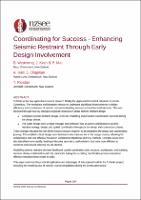| dc.description.abstract | Tuhiraki is a new agricultural science facility for AgResearch Ltd., situated in Lincoln, Canterbury. The workplace and laboratory structures witnessed significant improvements in design efficiency and coordination of seismic restraint to building services and architectural elements. This was achieved through two key changes to typical construction-phase seismic restraint design:
1.Compliant seismic restraint design and 3D brace modelling and proactive coordination occurred during the design phases.
2.The wider design team, project manager and contractor had an active contribution to seismic restraint strategy, design and spatial coordination throughout both the design and construction phases.
The provision of BIM-modelled seismic restraint elements facilitated spatial coordination with structure, architecture, and building services. This enabled critical design team decisions to be made earlier in the design process, allowing for collaborative and cost-effective resolution compared to traditional delivery methods. Complex areas were also identified more readily, leading to bespoke secondary steel solutions that were more efficient to construct and reduced potential on-site clashes.
The role of the seismic restraint engineer was elevated within this project, and aligned to the other design disciplines so they remained integral to the design and coordination journey. Active collaboration of the contractor in the in-ceiling coordination process ensured an effective transition from model to build. This paper examines the practical application and advantages of this approach within the Tuhiraki project, including the resulting success of seismic restraint installation during the construction phase. The lessons learned are valuable for future projects, particularly as seismic restraint engineering continues to evolve. | |

